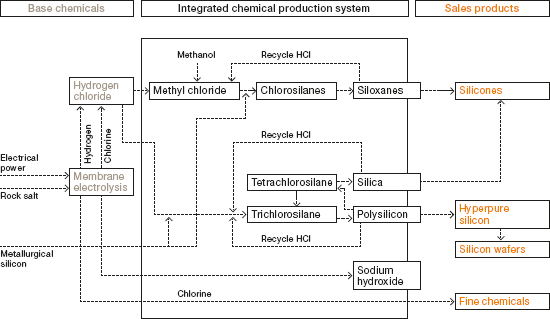WACKER’s integrated production system, primarily based on salt, silicon and ethylene as starting materials, is one of our greatest strengths. In our integrated processes, we optimize material efficiency by purifying by-products and reusing them or making them available for external use. In our integrated ethylene production system, for example, we use ethylene to obtain organic intermediates, which we then turn into polymer dispersions and dispersible polymer powders. Our integrated silicon production system operates along similar lines. Although comprising only a small number of raw materials – silicon, methanol and salt (sodium chloride) – this system enables us to manufacture over 3,000 silicone products, as well as pyrogenic silica and polysilicon.
A further focus of our integrated production is to minimize hydrogen chloride consumption. Hydrogen chloride is an essential auxiliary deployed in the production of reactive intermediates from energy-poor natural materials. We then use these intermediates to make our end products. Hydrogen chloride production requires a lot of energy. In our integrated material loop, we recover both hydrogen chloride and some of the energy in the form of heating steam during the conversion of the chlorine-containing intermediates to chlorine-free end products (e.g. hyperpure silicon or pyrogenic silica). We then return the recovered hydrogen chloride to the production loop and reuse it. This closed material loop reduces emissions and, due to lower raw material consumption, transportation.
For over ten years, we have been using a chlor-alkali membrane process to supply chlorine, hydrogen, caustic soda and hydrogen chloride as starting materials to our Burghausen site. This membrane electrolysis has enabled us to stop using mercury-based chlorine electrolysis and simultaneously cut energy consumption by 25 percent. Thus, WACKER has fulfilled the chemical industry’s voluntary commitment to phase out mercury-based processes by 2020 well ahead of schedule.

The use of low-temperature adsorption in polysilicon deposition has allowed us to save 15,000 metric tons of carbon dioxide annually since 2010. We now process hydrogen for re-use instead of extracting it from natural gas. As a result, we are able to reduce carbon dioxide emissions and improve the energy and CO2 balance of solar cells.
Zhangjiagang in China joins Burghausen (Bavaria) and Nünchritz (Saxony) as our third major integrated production site. In Zhangjiagang, WACKER and Dow Corning Corporation commissioned a production facility for pyrogenic silica and siloxane in November 2008. In late 2010, the facility reached an annual capacity of 200,000 metric tons. We rely on state-of-the-art environmental technology in China, too. There we operate facilities according to stringent international EH&S standards.

